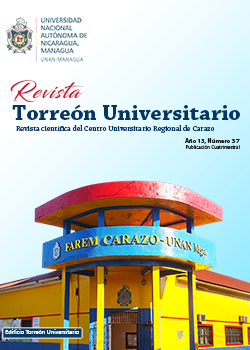Spanish as a foreign language course design according to learning needs
DOI:
https://doi.org/10.5377/rtu.v13i37.18174Keywords:
Needs analysis, Course design, Communicative forms, Target group, Communicative proposalsAbstract
The teaching of Spanish to foreigners for specific purposes is a relatively new discipline and has some characteristics that differentiate it from the teaching of Spanish in general. In this sense, this type of teaching is gaining more and more importance for socioeconomic and social reasons because more and more people are interested in learning a language focused on a specific purpose, as in the case discussed in this systematization in which attention was given to students with specific purposes. Hence, the main objective of this work is to describe the learning process and research on the learning needs of the target group to learn Spanish, who as a whole had clearly defined needs, focused on economic and social issues, since they are a group dedicated to the construction of horizontal works. The research was conducted using a qualitative approach. This methodology allowed the application of instruments and techniques with which it was possible to have a significant and direct impact on the target group (trainees). For the collection of information, an in-depth interview questionnaire was used to characterize the target group. To process the information obtained, the actions were divided into three fundamental phases, and interpretative analysis and characterization of elements were also used, for which a double-entry matrix was prepared, as well as analysis of the discourses. Theoretical and empirical methods made it possible to carry out an integral analysis (radiography) of the target group. The information triangulation technique was also applied and the relationship between the group's objectives and the contents to be developed was considered. The results of this research led to the proposal of a new line of research: a proposal or design of a course with specific purposes, especially for the personnel of the requesting institution.
Downloads
238
HTML (Español (España)) 30
PDF 42
HTML 15
References
Alcaraz Andreu, C. (s. a http://cvc.cervantes.es/ensenanza/biblioteca_ele/asele/pdf/17/17_0205.pdf.
Ellis, R. (1995). La motivación y la edad en la enseñanza de Lengua Extranjera en el contexto de intereses. Madrid, Alhambra Longman en funiber.
Lozano, D., & Plácido Ruiz , C. (1996). Criterios para el diseño y la evaluación de cursos y diseños de materiales comunicativos . Cuadernos de tiempo libre.
Zasón, J. (1990). Psicología y didáctica de las lenguas: una aproximación históricas y conceptual.
Downloads
Published
How to Cite
Issue
Section
License
Copyright (c) 2024 National Autonomous University of Nicaragua, Managua

This work is licensed under a Creative Commons Attribution-NonCommercial-NoDerivatives 4.0 International License.
Los autores que publican en esta revista están de acuerdo con los siguientes términos.
- El autor o los autores de los artículos, ensayos o investigaciones conceden a la Universidad Nacional Autónoma de Nicaragua, Managua (UNAN-Managua) los derechos de edición (copyright) del trabajo enviado, por consiguiente la Universidad cuenta con el derecho exclusivo para publicar el artículo durante el periodo completo de los derechos de autor.
- Estos derechos de autor/ autores autorizan a la Revista Torreón Universitario y a la Universidad editar y divulgar/publicar el artículo en dicha Revista, incluyendo reproducción impresa y electrónica, el almacenamiento, recuperación y cualquier otro tipo de publicación, y fuentes de información secundaria como servicios de resúmenes y bases de datos, así mismo la facultan a proteger el artículo contra el uso no autorizado para su difusión por medios impresos o electrónicos (PDF, HTML, EPUB, XML u otros).
Licencia para el uso del contenido
La revista hace uso de la Licencia Creative Commons Atribución-NoComercial-SinDerivar 4.0 Internacional.
Bajo esta declaración:

Este revista está sujeta a una licencia de Creative Commons Reconocimiento-NoComercial-SinObraDerivada 4.0 Internacional. Puede ser copiada, distribuida y transmitida públicamente siempre y cuando se cite al autor y la fuente (Revista Torreón Universitario), no debe modificarse ni utilizarse con ningún fin comercial. La licencia completa se puede consultar en http://creativecommons.org/licenses/by-nc-nd/4.0/.



